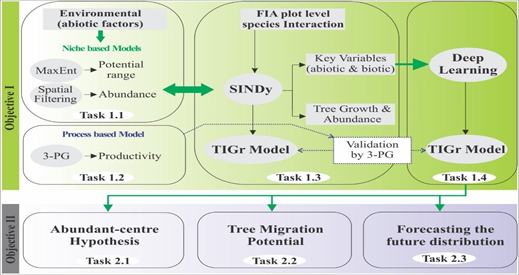Integrative data-driven modeling of species interactions on tree growth and migration
TIGr model development
Project Title: Integrative data-driven modeling to evaluate the impact of species interactions on tree growth and migration across environmental gradients
Accurate prediction of tree growth in response to environmental variations is a critical component of ecosystem management to minimize the negative impact of climate changes. Among many other factors, tree interactions at local scale are being recognized as one of the key determinants of tree growth and colonization. However, we currently do not have a complete understanding of how interspecific interactions affect the dynamics in tree communities and biogeographic responses. Consequently, accounting for tree interactions into mathematical modeling remains challenging, particularly due to (1) insufficient in situ experimental data and (2) the difficulty in taking insurmountable pairs of species associations into consideration. In this project, we address these challenges by developing predictive data-driven tree growth models through integration with other complementary approaches and demonstrating the effectiveness using Forest Inventory and Analysis (FIA), which provides consistent nationwide tree census information over 50 years.
We will depict future redistribution of eastern US tree species following three climate change scenarios and compare them with independent process-based predictions thus evidence-based effective forest management can be developed for climate change mitigation.